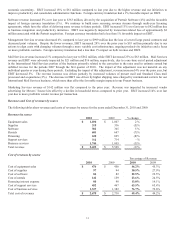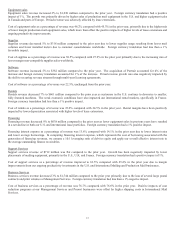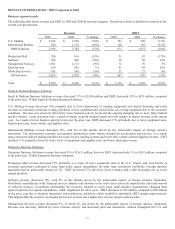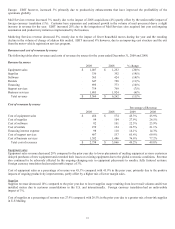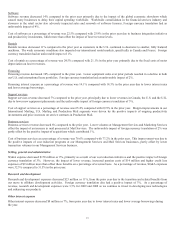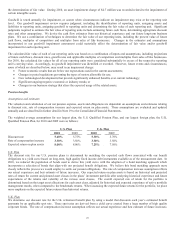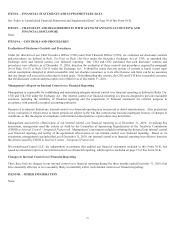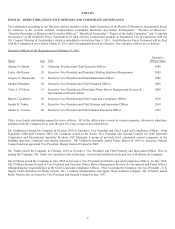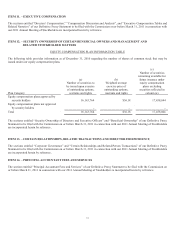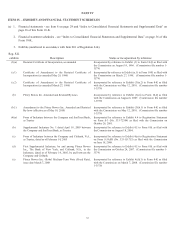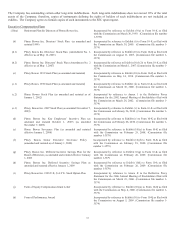Pitney Bowes 2010 Annual Report Download - page 42
Download and view the complete annual report
Please find page 42 of the 2010 Pitney Bowes annual report below. You can navigate through the pages in the report by either clicking on the pages listed below, or by using the keyword search tool below to find specific information within the annual report.23
Critical Accounting Estimates
We have identified the policies below as critical to our business operations and to the understanding of our results of operations. We
have discussed the impact and any associated risks on our results of operations related to these policies throughout the MD&A. For a
detailed discussion on the application of these and other accounting policies, see Note 1 to the Consolidated Financial Statements.
The preparation of our financial statements in conformity with GAAP requires management to make estimates and assumptions that
affect the amounts of assets, liabilities, revenues and expenses that are reported in the consolidated financial statements and
accompanying disclosures, including the disclosure of contingent assets and liabilities. These estimates are based on management’s
best knowledge of current events, historical experience, actions that we may undertake in the future, and on various other assumptions
that are believed to be reasonable under the circumstances. These estimates include, but are not limited to, allowance for doubtful
accounts and credit losses, inventory obsolescence, residual values of leased assets, useful lives of long-lived assets and intangible
assets, impairment of goodwill, allocation of purchase price to tangible and intangible assets acquired in business combinations,
warranty obligations, restructuring costs, pensions and other postretirement benefits and loss contingencies. We believe our
assumptions and estimates are reasonable and appropriate in accordance with GAAP; however, actual results could differ from those
estimates and assumptions.
Revenue recognition
Multiple element and internal financing arrangements
We derive our revenue from multiple sources including sales, rentals, financing and services. Certain of our transactions are
consummated at the same time and can therefore generate revenue from multiple sources. The most common form of these
transactions involves a non-cancelable equipment lease, a meter rental and an equipment maintenance agreement. As a result, we are
required to determine whether the deliverables in a multiple element arrangement should be treated as separate units of accounting for
revenue recognition purposes, and if so, how the price should be allocated among the delivered elements and when to recognize
revenue for each element.
In multiple element arrangements, we recognize revenue for each of the elements based on their respective fair values. We recognize
revenue for delivered elements only when the fair values of undelivered elements are known and uncertainties regarding customer
acceptance are resolved. Our allocation of the fair values to the various elements does not change the total revenue recognized from a
transaction, but impacts the timing of revenue recognition. Revenue is allocated to the meter rental and equipment maintenance
agreement elements first using their respective fair values, which are determined based on prices charged in standalone and renewal
transactions. Revenue is then allocated to the equipment based on the present value of the remaining minimum lease payments. We
then compare the allocated equipment fair value to the range of cash selling prices in standalone transactions during the period to
ensure the allocated equipment fair value approximates average cash selling prices.
We provide lease financing for our products primarily through sales-type leases. The vast majority of our leases qualify as sales-type
leases using the present value of minimum lease payments classification criteria. We believe that our sales-type lease portfolio
contains only normal collection risk. Accordingly, we record the fair value of equipment as sales revenue, the cost of equipment as
cost of sales and the minimum lease payments plus the estimated residual value as finance receivables. The difference between the
finance receivable and the equipment fair value is recorded as unearned income and is amortized as income over the lease term using
the interest method.
Equipment residual values are determined at inception of the lease using estimates of equipment fair value at the end of the lease term.
Estimates of future equipment fair value are based primarily on our historical experience. We also consider forecasted supply and
demand for our various products, product retirement and future product launch plans, end of lease customer behavior, regulatory
changes, remanufacturing strategies, used equipment markets, if any, competition and technological changes. We evaluate residual
values on an annual basis or as changes to the above considerations occur.
See Note 1 to the Consolidated Financial Statements for our accounting policies on revenue recognition.
Allowances for doubtful accounts and credit losses
Allowance for doubtful accounts
We estimate our accounts receivable risks and provide allowances for doubtful accounts accordingly. We believe that our credit risk
for accounts receivable is limited because of our large number of customers, small account balances for most of our customers and
customer geographic and industry diversification. We evaluate the adequacy of the allowance for doubtful accounts based on our
historical loss experience, length of time receivables are past due, adverse situations that may affect a customer’s ability to pay and



